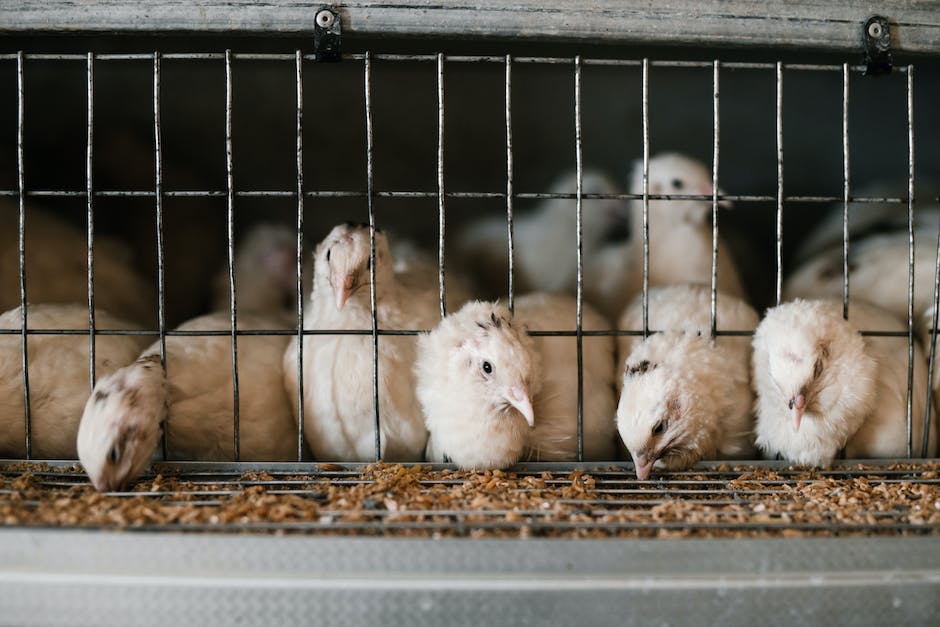

Agridisk
Egypt - Alexandria

Broiler chicken breeds | Broiler chicken feed
Description: Raising chickens for meat, known as broilers, has become a sophisticated field of agricultural science, drawing upon decades of genetic research, nutritional studies, and environmental considerations. The journey from egg to market-ready chicken is the result of meticulous breeding and care, aiming to optimize traits that benefit both producers and consumers. At the heart of this progress lie the intricacies of poultry genetics, where strategic selection methods have significantly improved growth rates, feed efficiency, and meat quality. With their profound impact on the industry, leading broiler breeds such as the Cornish Cross and Ross 308 have set the standards for performance and profitability. Unraveling the complexities behind these breeds, their optimum nutritional requirements, and the health strategies that safeguard their development sheds light on the monumental efforts involved in feeding a growing global population. Abstract: Broiler chicken breeds are an essential component of the global poultry industry, selected primarily for their rapid growth rates and meat production efficiency. Understanding the genetic basis underlying the characteristics of broiler chickens is paramount for ongoing improvements in breeding strategies. This article elucidates the relationship between genetics and the phenotypic traits of broiler chicken breeds. Introduction: The commercial broiler chicken is a scientific triumph of the 20th century, bred specifically to satisfy the increased consumer demand for poultry meat. The genetic selection process has transformed the broiler industry, optimizing traits such as growth rate, feed conversion ratio, muscle development, and disease resistance. Herein, we delve into the current understanding of how genetic architecture molds broiler chickens, focusing on quantitative trait loci (QTLs), single nucleotide polymorphisms (SNPs), and gene expression profiles that contribute to the distinct phenotypes observed within these breeds. Genetic Selection and Growth: The heritability of rapid growth in broiler chickens is a fundamental attribute conferred by selective breeding. Growth rate is influenced by genes that regulate metabolic pathways, hormone production, and muscle growth. The growth hormone (GH) and insulin-like growth factor 1 (IGF-1) genes are amongst those that have been found to play significant roles in the regulation of growth and body composition. Additionally, the myostatin gene, which inhibits muscle growth, has been a focal point, as mutations or reduced expression can lead to increased muscling in broilers. Feed Efficiency: Feed efficiency, defined as the ability of an animal to convert feed into body mass, is another critical economic trait shaped by genetics. Reduced feed conversion ratios are ideal for producing more meat with less feed. Variations in the thyroid hormone-responsive (THRSP) gene and genes involved with energy metabolism and appetite regulation, such as neuropeptide Y (NPY) and leptin receptors, have been linked to feed efficiency traits. Muscle Development: Muscle development and composition are essential for the meat quality of broiler chickens. Genes like IGF2 and fibroblast growth factor (FGF2) significantly contribute to muscle development and differentiation. Understanding allelic variations in these genes supplies indispensable information for the genetic improvement of muscle mass and meat quality. Disease Resistance: As with all livestock, disease resistance is a vital characteristic influenced by the host genome. Functional immune genes, such as the major histocompatibility complex (MHC), Toll-like receptors (TLRs), and cytokines, are central components determining the immune response to pathogens. Selective breeding for enhanced disease resistance aligns with the broader goal of reducing the use of antibiotics in poultry production. Behavioural Traits: Behaviour and welfare are becoming increasingly recognized as integral aspects of broiler breeding programs. Genetic influences on behaviour are complex, yet research has identified SNPs associated with fear response and activity levels, which can illuminate pathways to improve the welfare and overall performance of broiler chickens. Concluding Perspective: In sum, the interplay of genetics in broiler chicken breeds comprises an intricate web of influences that determine their growth, efficiency, health, and behavior. It embodies a perpetual frontier in agricultural science, where molecular genetics and genomics continue to pave the path for advancements in poultry breeding. The continuous unraveling of the genetic tapestry promises to augment the sustainability and productivity of the broiler industry, concurrently prioritizing animal welfare and environmental considerations. Broiler Chicken Breeds: A Closer Look at Leading Varieties and Their Distinct Characteristics The agricultural landscape perpetually evolves, propelled by relentless innovations, particularly within the poultry sector. Among various poultry breeds, broiler chickens represent a paramount industry segment, defined by their robust growth rates, optimised for meat production. Within this context, the primacy of certain broiler chicken breeds stands testament to rigorous selection protocols, aiming to harmonise productivity, health, and welfare. Three outstanding breeds—Ross 308, Cobb 500, and Hubbard Flex—garner much attention and dominate production settings globally. Each breed brings forward a suite of traits that serve as cornerstones for their ubiquity and preference among poultry producers. Each of these leading broiler breeds has been judiciously nurtured to manifest specific traits tailored to the rigorous demands of modern poultry production. These include not only their growth metrics but also the quality of meat they provide—an amalgamation of taste, texture, and nutritional value. Importantly, sustainability considerations are increasingly at the forefront, with each breed's environmental footprint under continuous scrutiny. The aforementioned attributes that characterise the leading broiler breeds are no mere happenstance; rather, they are the outcomes of calculated and strategic breeding programs. Through these, broiler breeds are constantly being refined and enhanced to suit evolving industry needs, market demands, and societal expectations regarding animal welfare and environmental responsibility. Ongoing research in poultry genetics holds promise for further advancements in these domains. The future may well behold broiler breeds with even more nuanced attributes aligning with the ethos of efficiency, sustainability, and ethical production. As these breeds are foundational to the poultry industry, the continued elucidation of their characteristics remains a critical endeavor for agricultural scientists and commercial breeders alike. Optimal Nutrition for Enhanced Growth in Broiler Chickens Ensuring adequate nutrition is paramount in achieving the desired growth rates of broiler chickens. Precise nutritional strategies must be tailored to support the maximum genetic potential of these birds, taking into account their remarkable growth rates and muscle development needs. Such nutritional plans focus on specific requirements that encompass energy, protein, amino acids, vitamins, and minerals, all of which interact intricately to promote healthy, efficient, and sustainable broiler production. Energy and Protein Balance: The Cornerstones of Broiler Nutrition The basal requirement for energy intake in broilers is dictated by the need to fuel an accelerating growth trajectory. Diets are primarily formulated based on energy content, typically from carbohydrates in grains such as corn and wheat, with considerations for lipid supplements for higher caloric density. Protein, on the other hand, is critical for muscle accretion and tissue repair. Sources are typically plant-based, like soybean meal, but may also include animal-based components to provide a full profile of dietary amino acids. Essential Amino Acids: The Building Blocks of Growth Lysine and methionine are paramount among amino acids for broilers, serving as key components in muscle protein synthesis. Lysine is often the first limiting amino acid in poultry diets and thus requires careful balancing to ensure its availability does not hinder growth. Methionine, coupled with cysteine, is essential for feather development and optimal metabolism. Vitamins and Minerals in Broiler Nutrition A spectrum of vitamins including A, D, E, and B-complex, along with essential trace minerals such as zinc, selenium, and manganese, are requisite to support a range of physiological functions. These include bone development—vitamin D and calcium being prime examples—immune response, and metabolic processes. Due to the rapid growth rates, broiler chickens have heightened needs for these micronutrients, markedly higher than their egg-laying counterparts. Optimizing Gut Health and Nutrient Absorption Digestibility and bioavailability of nutrients are critical in making the most of feed inputs, requiring a focus on gut health. Probiotics and prebiotics play roles in enhancing the gut microbiome, optimizing nutrient absorption, and providing non-specific health benefits to the birds. Enzymes such as phytase can improve the availability of phosphorous from plant sources, reducing the dependency on inorganic phosphate supplements and thereby decreasing the environmental impact of poultry production. Balancing Nutrient Uptake with Sustainable Practices While maximizing growth and production is important, the manner in which this is achieved cannot be detached from environmental considerations. Effective nutrient management, which includes optimizing the protein content to minimize nitrogen excretion, is a core component of sustainable broiler nutrition. The Integration of Nutritional Strategies with Welfare Aligning nutritional provision with the welfare of broiler chickens is a contemporary consideration that cannot be overlooked. Ensuring adequate space, access to feed and water, and environmental enrichment is as critical to optimal growth as the nutrients provided. Stress reduction via management and nutrition correlates positively with growth performance and overall health status. In summation, broiler nutrition is a multifaceted discipline that interfaces with genetics, metabolism, chicken physiology, and emerging welfare concerns to direct the composition of broiler diets. This must be done while also prioritizing the efficient conversion of feed into muscle mass, essential for the economic viability of broiler production. As the industry progresses, special attention will continue to be focused on refining dietary formulations to enhance performance, sustainableness, and the well-being of broiler chickens. In the realm of broiler chicken production, health management emerges as a linchpin to actualize the biological potential developed through meticulous genetic selection and nutritional advancements. This discipline assumes a multifaceted character, involving vigilant surveillance, preemptive strategies, and responsive medical interventions. Biosecurity measures constitute the bedrock of health management, ensuring a steadfast shield against pathogenic incursions into poultry operations. The establishment and enforcement of rigorous biosecurity protocols serve as non-negotiable pillars to attenuate the ingress and proliferation of diseases. In practical terms, this extends to the regulation of human traffic within facilities, the application of disinfection regimens, and the control of vectors and wildlife that may harbor detrimental organisms. Vaccination strategies play a cardinal role in the armamentarium against infectious agents, conferring immunity to delicate broiler populations. The judicious selection, timing, and administration of vaccines sit at the crux of prophylactic healthcare in broilers. The objective is to elicit robust immunity without inducing undue stress on the birds, which could paradoxically predispose them to other health issues. Stress reduction remains inseparable from the health management equation, for stress is a well-documented precursor to immunosuppression in avian species. Reducing stress involves optimizing the broilers' environment, including maintaining adequate temperature, humidity, and ventilation parameters, as well as providing sufficient space and enrichment. These endeavors not only improve animal welfare but directly influence flock wellbeing by promoting a resilient physiological state. Monitoring and data analysis are indispensable tools in the contemporary health management repertoire. Real-time data collection systems that record everything from feed and water intake to behavioral patterns provide a comprehensive picture of flock health status. Rapid detection and targeted management of anomalies in such parameters potentially avert outbreaks of disease or mitigate their impact, safeguarding the well-being of chickens and the economic viability of poultry ventures. Antimicrobial stewardship, while beyond the pale of new frontiers, is garnering renewed emphasis in the wake of global concerns over antibiotic resistance. Prudent use of antimicrobials—resorting to them only when necessary and following evidence-based guidelines—strikes a balance between protecting flock health and curbing the development of resistance. The poultry industry is increasingly exploring alternative strategies, such as the use of organic acids, phytogenics, and bacteriophages, to manage health issues without relying on conventional antibiotics. Environmental sustainability, intertwined with all aspects of broiler health management, warrants meticulous consideration of waste management, judicious use of resources, and the adoption of renewable energy sources within production systems. Such practices not only fulfill ethical obligations towards the planet but also contribute to the health and productivity of broiler chickens by fostering a clean and conducive environment. In the final analysis, the holistic approach to health management in broiler production is a complex but non-negotiable endeavor. It merges the expertise of veterinarians, avian health specialists, geneticists, nutritionists, and welfare experts in an interdisciplinary symphony, composed with the singular aim of fostering the health, well-being, and productivity of broiler chickens. This intensive pursuit remains the bedrock upon which the broiler industry can sustainably meet the burgeoning global demand for poultry products, ensuring that progress in genetic and nutritional realms translates into tangible outcomes. Environmental Considerations in Optimizing Broiler Chicken Productivity The prodigious growth and feed conversion rates of broiler chickens attest to the remarkable progress in genetic selection and nutritional science; however, environmental factors play a pivotal role that manifests across the entire spectrum of broiler productivity. These entail the physical housing systems, ambient environmental conditions, and prevailing management practices—all of which concomitantly influence the well-being and growth performance of broilers. Chief among environmental factors is the thermal environment. Broiler chickens are poikilotherms, lacking the innate physiological means to regulate their body temperature effectively. Consequently, they are highly susceptible to temperature fluctuations, with optimal productivity witnessed within a thermoneutral zone. This zone varies with the age of the birds but typically hovers between 18°C to 24°C for mature broilers. Temperatures deviating from this range induce thermal stress, compelling the birds to divert energy from growth to temperature regulation. Thus, maintaining a stable thermal environment is crucial for maximizing growth rates and feed conversion efficiency. Notably, air quality within the broiler housing also wields significant influence. Ammonia, emanating from the decomposition of litter, can impair respiratory health and epithelial defenses when it reaches deleterious concentrations. Elevation in aerial bacterial and particulate matter levels can potentiate respiratory infections, detrimentally affecting growth and survivability of broilers. Accordingly, ventilation systems must be meticulously designed and managed to ensure the constant renewal of air and maintenance of appropriate airborne contaminant levels. Lighting programs, albeit often understated, are another cornerstone of environmental management. The intensity and duration of light exposure can regulate circadian rhythms, directly influencing feeding behavior, physiological cycles, and ultimately, productivity. Current research delineates the potential for tailored lighting programs to enhance growth by modulating activity patterns and optimizing feeding windows. Moreover, auditory stimuli within the rearing environment can exert a subtle yet substantial impact. Chronic noise pollution not only serves as a stressor but may also disrupt communication, impairing social dynamics and triggering unfavorable behavioral patterns among the flock. Furthermore, spatial density is a parameter with far-reaching effects. Overcrowding can precipitate the proliferation of pathogens, elevate stress through aggressive encounters, and curtail access to feed and water, all of which are to the detriment of overall productivity. As such, adherence to appropriate stocking densities ensures sufficient access to resources while mitigating the spread of diseases. Finally, the texture, composition, and management of litter hold paramount importance. The choice of litter material affects not only the comfort and foot health of broilers but also their propensity to engage in natural behaviors, such as foraging and dustbathing. Moreover, effective litter management practices aid in controlling moisture levels and minimizing the emergence of enteric pathogens. In conclusion, the productivity of broiler chickens is inextricably linked to the confluence of genetic potential and nutritional optimization, yet the environment within which they are reared commands an equally critical role. It is through the fastidious control and fine-tuning of environmental parameters that the industry can secure the well-being of these avian counterparts while sustaining the burgeonment of productivity sought after in modern broiler operations. The poultry industry, specifically broiler chickens, has been an essential and evolving part of the global food chain. Our exploration into the broiler chicken feed sector uncovers a multitude of important aspects that shape this critical industry. We delve into the current market, nutritional requirements, technological advances and economic feasibility in the quest to appreciate the complexities and challenges involved in meeting the dietary needs of broiler chickens. Embarking on this exploration, we remain mindful of the importance of environmental sustainability, seeking to examine the ecological footprint of such an essential industry. The broiler chicken feed market, while not at the forefront of every investor's mind, is nonetheless a critical factor in one of the largest global industries: poultry. This bustling, high-demand sector is continuously influenced by the intersection of three pivotal market forces: consumer trends, environmental sustainability, and technological innovations. Currently, consumer trends are largely driving the changes in this industry. With the spotlight on health, nutrition, and quality of food, consumers demand transparency in their poultry products. As a result, the broiler chicken feed market is rapidly embracing organic, non-GMO, and antibiotic-free options. Moreover, the tide of environmental sustainability is not leaving this industry untouched. The surging interest in biosecurity, waste management, and reduced carbon footprint are reshaping what broiler chicken feed looks like. Today, manufacturers are increasingly experimenting with alternative ingredients in the bid to go green, with a significant uptick in the use of insect and algae-based meals. While these forces have historically defined the market trends, it is technology that's anticipated to bring about the next revolution in this sector. Precision feeding technologies promise to minimize wastage and maximize output, ensuring a much more efficient feed to meat conversion ratio. Technologies like sensors and artificial intelligence would allow for real-time monitoring and data-driven decision making. So, what does the future hold? Let's put on our forecasting hat. By 2025, it's projected that the global broiler chicken feed market will reach a staggering $116.9 billion, driven by progressions in nutrition, environmental sustainability, and technology. The focus will likely continue to be on producing healthier, tastier broilers, concurrently lowering the environmental impact of production. Interestingly, it's anticipated that sources of alternative protein such as insects, algae, and bacteria will become mainstays in broiler diets, providing a robust solution to the sustainability issue. Technology will indubitably continue to make inroads, potentially disrupting the industry. Imagine being able to adjust chicken's feed based on its metabolic rate or environmental conditions. That's the promise of precision feeding technology. Nevertheless, it won't all be uphill. Challenges concerning food safety and regulatory norms could play the spoilsport. To tread these waters wisely, one will need to comprehend and engage with the evolving regulatory landscapes across the globe. In summary, between now and 2025, the broiler chicken feed market will not just grow, but it will evolve, adapt, and expand beyond traditional boundaries. Keep an eye on this dynamic sector, because opportunities are undoubtedly perched on the horizon. As the broiler chicken feed market continues its upward trajectory with improved profitability and innovation, understanding the nutritional factors that influence feed composition is crucial for stakeholders. Currently, a significant factor that shapes the composition of broiler chicken feed is the understanding of nutritional needs at various growth stages. From hatching to adulthood, differing nutritional requirements necessitate specific feed compositions. For the first couple of weeks, high energy and protein content is vital, whereas later life stages require increased caloric input and a balance of vitamins and minerals, such as calcium and phosphorous, which contribute directly to skeletal development and overall health of the broilers. The balance of macronutrients - proteins, fats, and carbohydrates - is another key factor. Expertly determining the ratio of these elements directly impacts growth rate, feed conversion ratios, and resulting meat quality. Innovators in this space utilize advancements in nutrition research to deliver the optimal blend of these elements in their feed products. Another focus of the feed composition is the use of additives, ramped up by broader industry trends of harnessing natural compounds to improve health and productivity. Prebiotics, probiotics, and organic acids, for instance, are gaining traction. These compounds not only improve the gut health of broilers, hence enhancing nutrient absorption, but also help mitigate potential pathogenic threats, thus improving overall broiler health and productivity. Consideration must also be given to the digestibility of these feed components. Digestible feed implies better nutrient absorption, leading to direct growth improvements and better feed efficiency. Employing easily digestible elements such as nutrient-dense plant protein sources or highly digestible animal protein can significantly influence the efficiency and effectiveness of broiler growth. Finally, there’s the topic of nutrient sourcing and its ethical and sustainable implications. Proactive leaders in the sector are acknowledging the necessity of securing sustainable sourcing solutions such as alternative protein sources all while ensuring those solutions do not compromise on nutritional value. With rising market dynamics and shifting consumer trends, the importance of comprehending these nutritional factors cannot be overstated. Stakeholders, investors, and innovators who carefully consider these components when formulating their broiler feed strategy will likely be rewarded with competitive advantage, improved customer satisfaction, and stronger profits in the promising future of the broiler chicken feed market. Performance Metrics: The Key to the Broiler Chicken Feed Industry's Future In the ongoing metamorphosis and advancement of the broiler chicken feed market, two integral components have come to the fore – performance metrics and customized feed compositions. Unsurprisingly, data and analytics are driving changes in an industry deeply aligned with consumer demands and sustainability. Measuring and analyzing performance indicators, like feed conversion ratio (FCR), average daily gain (ADG), and mortality rates, are absolutely critical when it comes to optimizing yields while improving animal welfare. These metrics serve as key benchmarks to ascertain and adjust feed formulas, fostering a high-performance flock. Moreover, data collection and real-time tracking of physiological traits can help identify optimal feed formulation. Imagine, for a moment, you could provide a bespoke diet to each bird that matches its unique nutrient requirements. Think about the profound impact this might have on boosting productivity while enhancing flock health. Feed composition that caters to the differing nutrient requirements of a broiler chicken throughout its growth stages is another point of significant disruption. Gone are the days of one-size-fits-all models. Tailoring feed regimes that reflect age-specific metabolic rates and protein requirements is now a strategic imperative for farmers. During the initial weeks of broiler chicken growth, feed with high energy and protein content helps meet the birds' nutritional needs and supports their rapid growth. The focus shifts towards an increased caloric input and balance of vitamins and minerals to bolster muscle and skeletal development in the birds' later life stages. The intriguing role of additives in the broiler chicken feed mix is another area drawing interest. For instance, probiotics, prebiotics, and organic acids can help improve gut health, proving instrumental in promoting more efficient nutrient absorption, and subsequently enhance productivity. Also, shedding light on feed digestibility, an often overlooked, yet vital aspect, is the key in determining growth improvement. It's not just about the nutrients you feed the birds, but how well those nutrients are utilized. Promoting ethical and sustainable sourcing of nutrients, following the trend of alternative protein sources like insects and algae, could lead to the actualization of an environmentally friendly cycle of feed production. Customer preferences and market dynamics are, undoubtedly, ordinances all players must follow. The successful will be those that foresee shifts, harness new technologies, and seek to innovate at every corner. Similarly, the alignment between business operations and social responsibility will play a pivotal role in sculpting the future of the broiler chicken feed industry. This industry, bound by its indomitable link to food security, presents a plethora of opportunities for the savvy investor willing to seize them. By understanding its complexities and keeping the finger on the pulse of technological innovations, one can make computed, profitable decisions. Change, as they say, is the only constant. Those who resist it in the broiler chicken feed industry will inevitably find themselves left behind. However, those who welcome it with an innovative mindset will stand to reap the rich rewards of a future full of promise. Determining the most cost-efficient feed is not simply a matter of comparing prices. It is an intricate equation encompassing the nutritional value of the feed, yield of broiler meat per feed unit, and health implication for the broilers in the long run. Consider this; a feed that is initially cheaper but results in slower growth rates, lower meat yields, or heightened health issues may carry a higher overall cost when measured against the return on investment (ROI). On the contrary, a more expensive feed rich in nutrients, promoting rapid and healthy growth, may offer a better ROI. Cost is important, but the value delivered by the feed, measured using key performance metrics such as feed conversion ratios (FCR) and average daily gains (ADG), is paramount. Further compounding the focus on cost-effectiveness with the increasing trend toward natural feeds. Many consumers today demand transparency, preferring their meat sourced from broilers fed antibiotic-free and organically certified feeds. These types of feed, while more expensive, fetch a higher market price due to consumer demand, yielding potential higher margins for poultry producers. There have been significant strides in optimizing feed efficiency and cost-effectiveness using technology. Data analytics, modeling, and simulations allow us to better understand broiler health, nutritional requirements, and feed efficiency, thereby creating more cost-optimized feeds. Similarly, innovations in feed additives like probiotics and organic acids have improved gut health and nutrient absorption, leading to better overall health, faster growth, and improved yields. The cost-effectiveness of broiler feed is also linked to the sustainability of the broiler industry. Sustainable feeds that result in less environmental impact can safeguard a business from future regulatory risks and enhance its brand image among environmentally conscious consumers. Therefore, cost-effectiveness is not only about short-term gains but also about long-term survival and growth. It isn’t just about sourcing the cheapest feed, but rather it’s a complex dance involving pricing, nutritional values, broiler health, consumer preferences, regulations, technology, and environmental sustainability. The feed isn't just about filling a chicken; it's fueling an industry and responding to a rapidly changing, dynamic economic and societal landscape. Innovation, adaptation, and smart investments will ensure that cost-effective doesn't compromise overall value. While the previous sections have delineated the specifics of the broiler chicken feed industry, it's crucial to probing how sustainable production factors into the broader theme of environmental conservation. It's not a detached aspect but an integral component of this global concern. Here, we delve into a more detailed spectrum, exposing how sustainability principles are applied in feed production and how they contribute towards nurturing our planet. Maintaining ecological balance is no less of a concern in the broiler feed production sector. Opting for locally sourced raw materials, for instance, significantly reduces the industry’s carbon footprint by curtailing transportation and related emissions. Furthermore, incorporating agricultural by-products into the feed not only optimizes resources, but also aids in waste management, turning the industry into part of the solution rather than the problem. This industry is uniquely placed to influence environmental conservation. By embracing alternative protein sources such as insects and algae, the feed manufacturers can alleviate pressures on conventional fish and soya stocks; they also contribute indirectly to the reduction of overfishing and deforestation. Additionally, feed mills are initiating practices that imbibe principles of energy efficiency, reducing demand on power resources. Exploring renewable energy sources like solar or wind power for operations manifests as another viable move towards sustainability. Sustainability is not just about preserving resources. It's about preserving the health and welfare of the broiler chickens and by extension, those consuming these products. Antibiotic-free and organically certified feed have emerged as steps in this direction, representing consumer preferences for health while reducing the rampant dependency on medications in the poultry sector. Regulatory measures have been tightening in recent years favoring more ecologically friendly alternatives. Complying with these norms not only supports environmental upkeep but also opens opportunities to earn public trust, reputation, and expanded market share. Pioneering new technologies are also reshaping the industry to favor environmental soundness. Precision feeding technologies, sensors, and artificial intelligence are clear evidence of how innovation can reshape an industry to be more planet-friendly. Precision feeding, to be precise, curtails overfeeding and waste while contributing to the chickens' overall well-being. As consumers become progressively aware and demand transparency, enterprises need to align their policies and practices accordingly. Sustainable production is a win-win situation. It meets consumer expectations, ensures regulatory compliance, enhances brand reputation, and supports planetary well-being. Lastl Sustainable broiler chicken feed production isn't just a choice; it's an obligation towards the planet and its beings. Embracing it is embracing a future of prosperity, health, and continuity. Realizing the interdependence of all elements in the ecosystem is crucial, and in this awareness lies our hope for a better future. As we look to the future of broiler chicken feed, it's key to emphasize that while structural and financial efficiency is important, it shouldn't come at the cost of nutritional efficacy or environmental sustainability. The recent innovations and technological advancements provide hope for a wave of change in the industry, enabling cost-effectiveness while not compromising on the quality or the sustainability of the production. The elements of the feed industry don't operate in a vacuum; changes in one aspect are bound to ripple through and affect others. With a growing commitment to sustainability and technological advancements, the broiler chicken feed industry can anticipate a future filled with impactful growth and sustainable practices.Broiler chicken breeds | Broiler chicken feed
Broiler chicken breeds
Genetics and Breed Selection | Broiler chicken breeds
The Genetic Underpinnings of Broiler Chicken Phenotypes
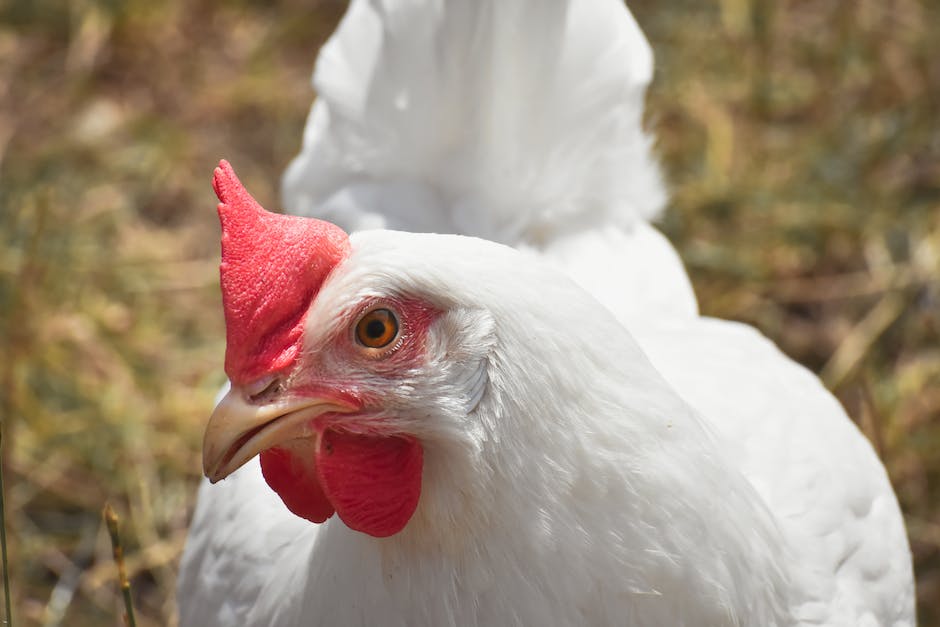
Leading Broiler Breeds and Their Attributes | Broiler chicken breeds
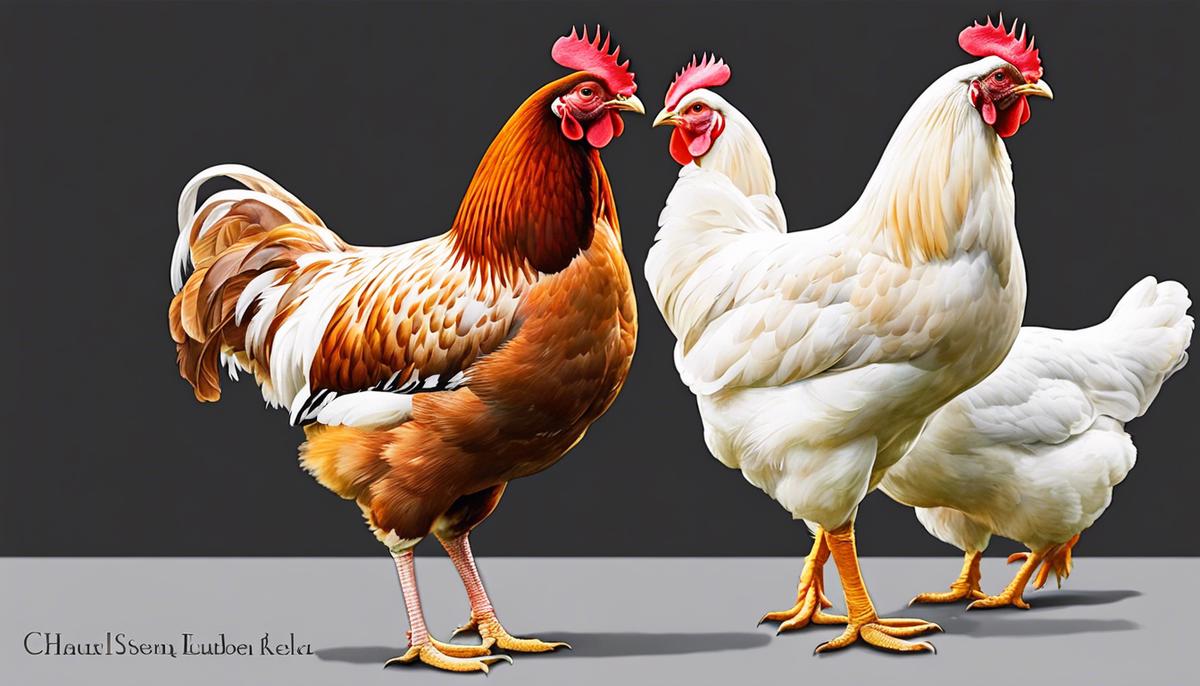
Nutritional Requirements of Broilers | Broiler chicken breeds
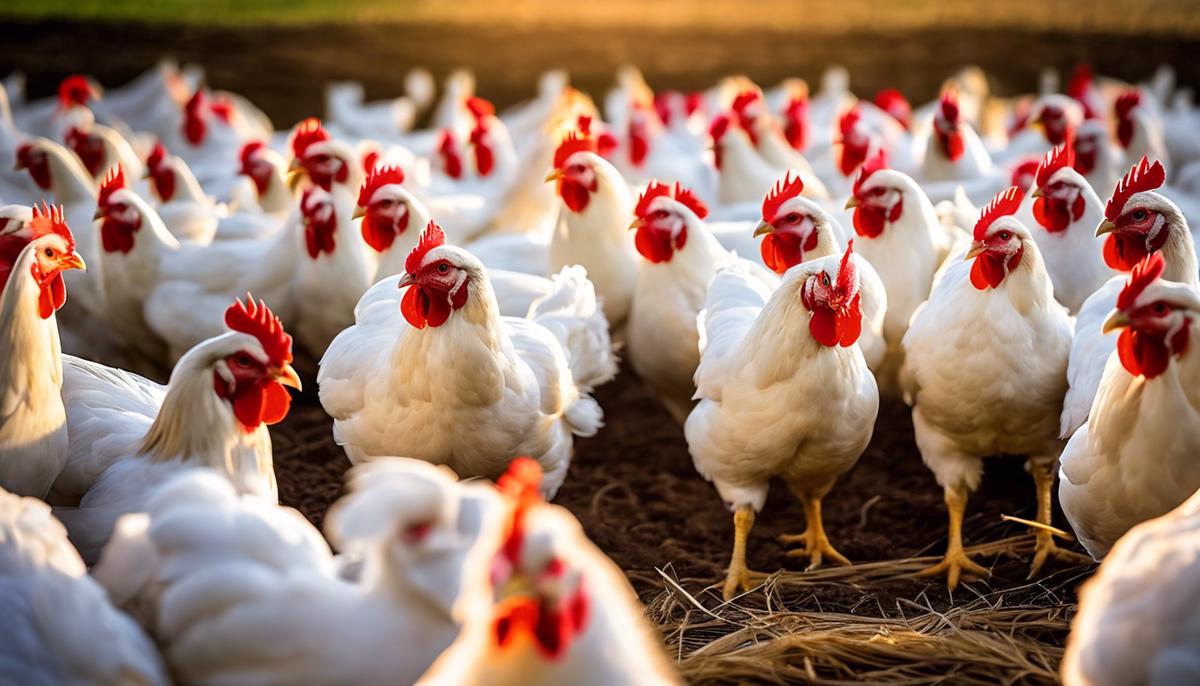
Health Management in Broiler Production | Broiler chicken breeds
The Imperative of Health Management in Broiler Chicken Production
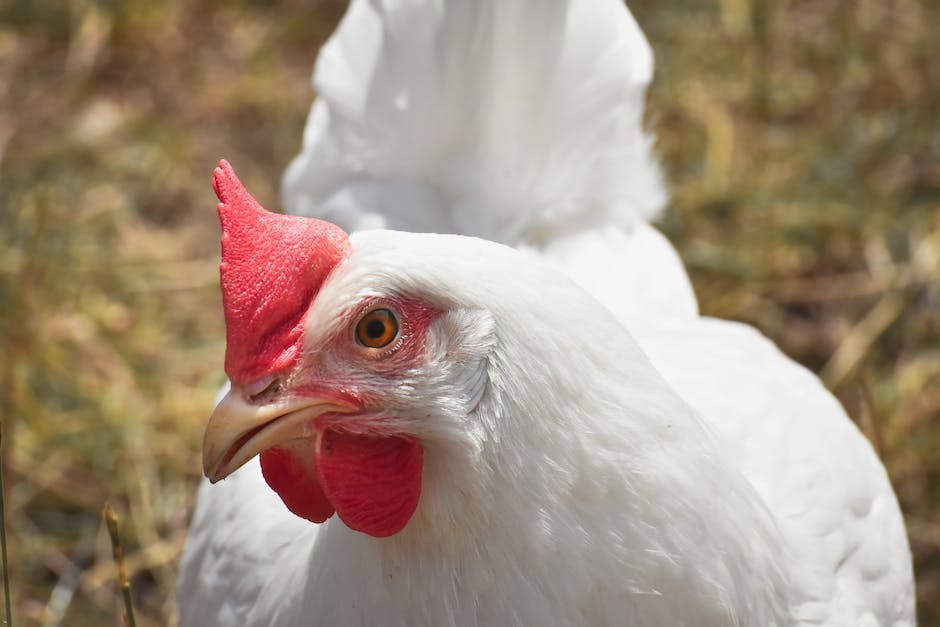
The Impact of Environment on Broiler Production | Broiler chicken breeds

Broiler chicken feed
Market Analysis on Broiler Chicken Feed
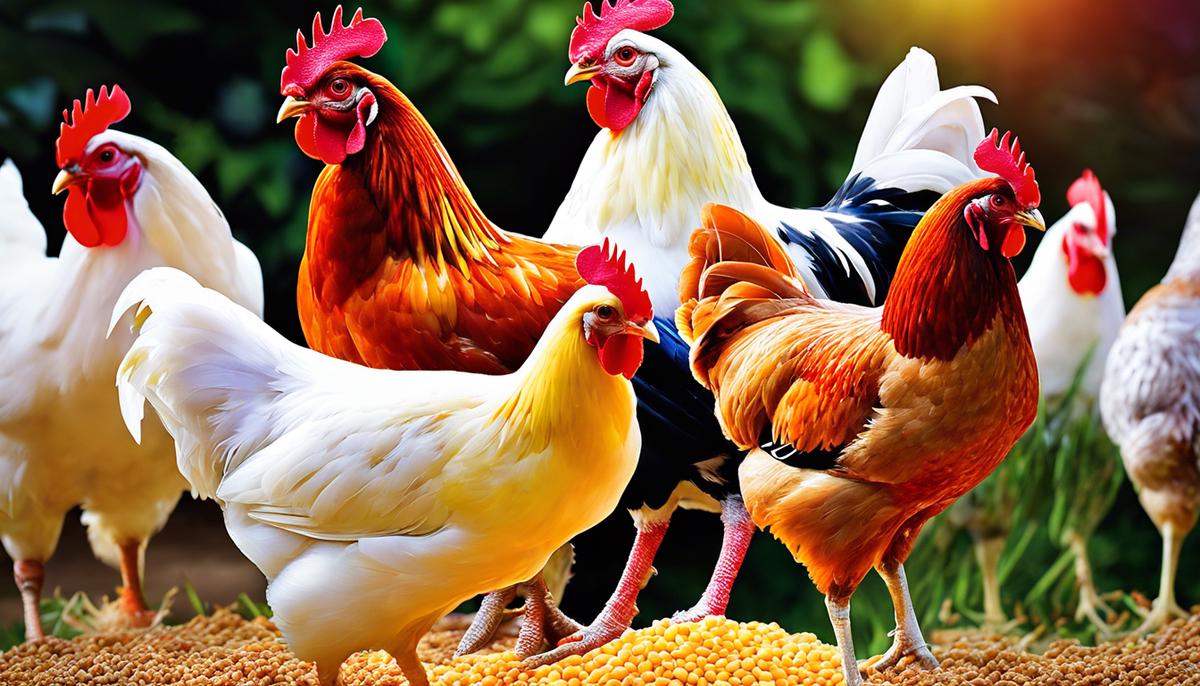
Nutritional Requirements and Feed Composition | Broiler chicken feed
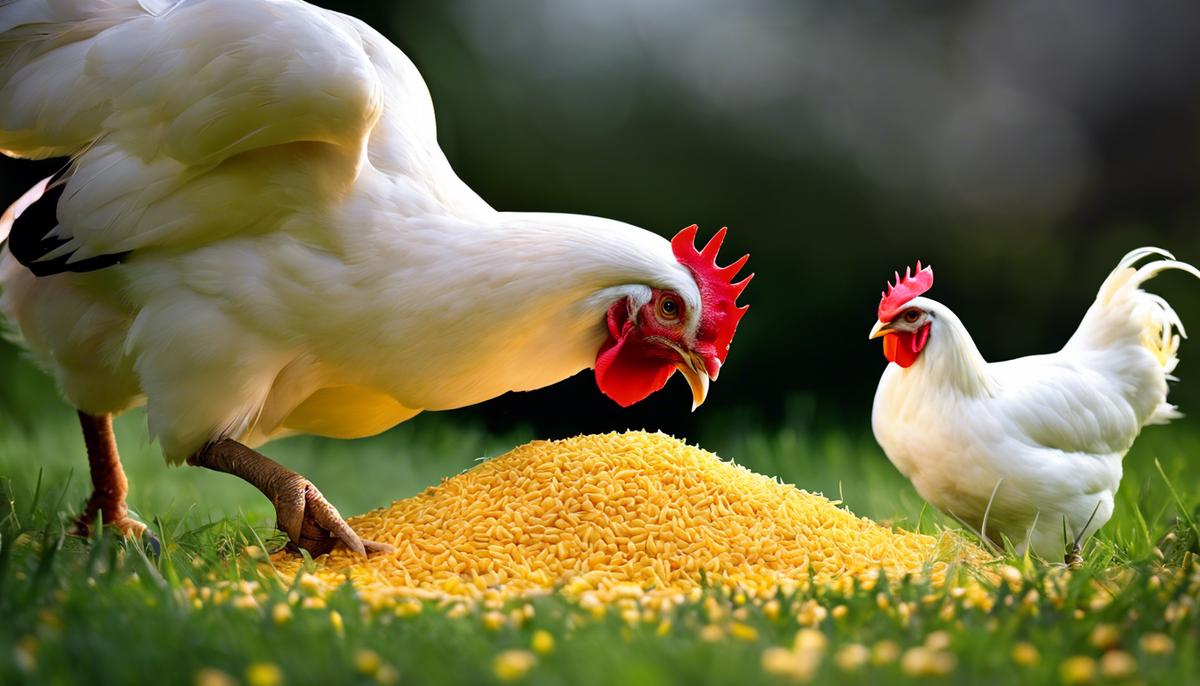
Innovation and Technological Advancements | Broiler chicken feed

Economic Feasibility of Feed | Broiler chicken feed
Undoubtedly, the cost-effectiveness of various feeds has a significant impact on the broiler chicken industry, determining profits, growth, and sustainability. Cost, however, must not be considered in isolation. Quality, efficiency, health implications, and environmental concerns also play pivotal roles in determining the strategic approach towards feed sourcing and formulation.
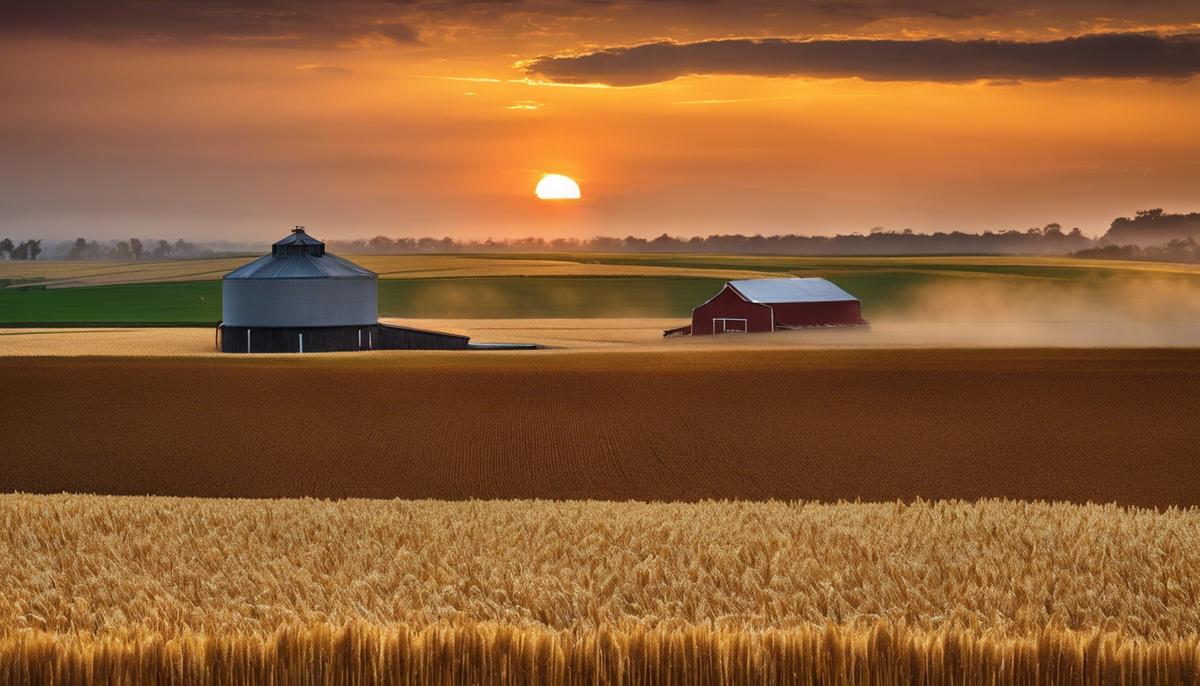
Environmental Sustainability | Broiler chicken feed
